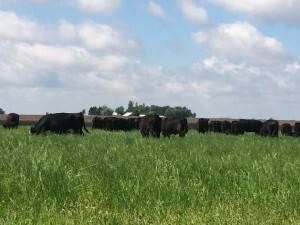The public comment period has been extended through May 8 relating to proposed updates to the Dietary Guidelines for Americans that call for reducing red meat intake due to saturated fat levels and environmental impact.
 As a Weight Watchers affiliate, I appreciate the DGAC’s efforts to emphasize eating more fruits, vegetables and whole grains. These are things I’ve strived to implement myself in my three-year health journey with Weight Watchers. As someone who has been raising beef in North Central Iowa for 15 years, I am disappointed that “dietary guidelines” question the sustainability of production practices.
As a Weight Watchers affiliate, I appreciate the DGAC’s efforts to emphasize eating more fruits, vegetables and whole grains. These are things I’ve strived to implement myself in my three-year health journey with Weight Watchers. As someone who has been raising beef in North Central Iowa for 15 years, I am disappointed that “dietary guidelines” question the sustainability of production practices.
Below are three main points I will address in my comments to the federal government:
1. Keep the focus on food nutrition, not on production practices.
The call for a reduction in red meat consumption is based on the claim that a plant-based diet reduces the carbon footprint. Please remember that major agricultural states across the Midwest have about a six-month growing season. Right now my garden is frozen tundra. Does their study account for the carbon needed to transport fruits and vegetables to areas where they aren’t in season?
I’ve been involved with the Weight Watchers organization for more than three years and have lost 54 pounds on the program. The program teaches members to enjoy all foods in moderation with emphasis on incorporating more servings of fruits and vegetables into daily choices. Because I’m a beef producer, the protein accompanying fruits and vegetables on my plate is usually beef. I’m on year two of maintaining my weight loss and enjoying great reports from the doctor. My focus is on balance, and I’ve learned to make great food choices. I don’t need another label on food to help complicate that decision. The dietary guidelines should focus on healthy foods, and lean beef is a healthy choice.
2. Beef is an excellent source of lean protein and other important nutrients.
Today’s beef is leaner than ever. According to a Fresh Beef Marketing Group survey, nearly 70 percent of all beef cuts sold at the grocery stores are lean. Popular cuts fitting this category include Top Sirloin, Tenderloin, T-Bone steak and 95% lean ground beef.
Consuming beef daily as part of a heart-healthy diet can lower LDL cholesterol levels by as much as 10 percent. Beef is a primary source of monounsaturated fat, the same type of heart-healthy fat found in olive oil. Most importantly, lean beef is one of the most naturally nutrient-rich foods with 10 essential nutrients including protein, zinc and B vitamins for less than 10 grams of fat per serving.
3. Farmers already incorporate sustainable practices to raise lean beef. While I don’t believe sustainability has a place in dietary recommendations, I’d like to point out that farmers are indeed implementing sustainable production practices. On my farm, we embrace a series of sustainable practices to raise our cattle and corn for feed.
- During the summer and fall months, we graze our cattle on land that is not suitable for crop production.
- We follow a rotational grazing system, which allows proper regrowth and recovery for the grasslands each season.
- During the winter months, when our herd is housed in the barnyard, manure is collected and applied to corn acres as organic fertilizer. All of these measures ensure integrity of the land is maintained while reducing our need for additional fertilizers to raise the corn to feed the cattle.
Let’s keep the focus on helping Americans select healthy, wholesome foods for their diet. Leave the task of implementing sustainable practices to provide those healthy foods in the hands of our farmers. If you’re a farmer, I urge you to submit comments by midnight May 8. If you’re a consumer with questions about cattle production and sustainability, I urge you to engage in a conversation with a farmer like me!
